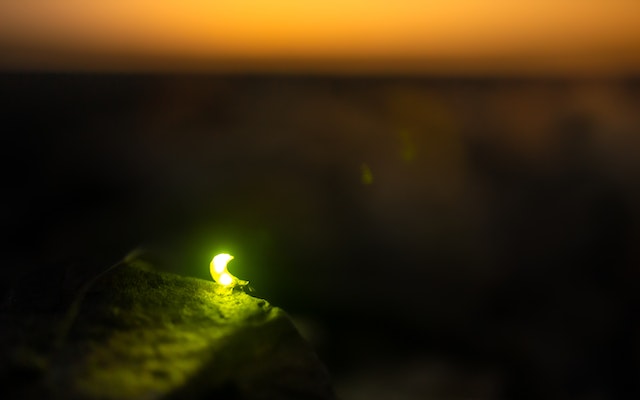
How do fireflies glow? They combine a chemical called luciferin, an enzyme called luciferases, oxygen, and fuel.
Fireflies are not actually flies; they are beetles. They are also not one single type of beetle. They come from a family of beetle called Lampyridae, which contains about 2,000 different types of beetles and nearly all of them emit light.
So, why do fireflies emit light? They do it for two reasons: to ward off predators and to attract a mate. Fireflies produce a chemical that makes them toxic to a lot of predators and taste bad to many more. This chemical is a steroid called lucibufagin. The chemical makes most animals that eat fireflies sick and they usually regurgitate the beetle. There are some frogs and lizards that can stomach the chemical, but fireflies have very few predators. They produce light to signal this to any potential predators, so they don’t get eaten by mistake. Some other insects try to copy this firefly glow as a defense mechanism of their own.
The second reason is to find a mate. Different species of firefly flash in a different way, as a signal to their own species. The males fly above the ground, about a meter up, and they flash their species pattern every few seconds. The females sit in bushes or on other vegetation and wait. When they see a flash from their own species, they flash back, signaling to the male where they are, and the two fireflies mate.
Fireflies have very few predators because of the chemical they produce, but they actually do have a surprising predator. Fireflies are quite often eaten by other fireflies. There is a species of firefly called photuris that cannot produce their own toxic chemicals. They have evolved to get around this by eating the fireflies that can produce it, and using the chemicals themselves. Photuris fireflies mimic the signal of other female fireflies and then eat the males that come down to mate.
So, how do fireflies produce light? They have an organ in their abdomen that is responsible for producing light. Inside these organs are cells that contain a chemical called luciferin. They also produce an enzyme called luciferase. Luciferin is a chemical that can produce light when it is exposed to oxygen and an energy source. When the firefly wants to glow, it takes oxygen into this organ through a breathing tube in its abdomen. It can alter the amount it glows by how much oxygen it “breathes” in. The oxygen comes into contact with the luciferin and the firefly adds ATP from its cells as an energy source. ATP is adenosine triphosphate and it is present in our cells as well. It is a molecule that stores energy in cells. The energy is stored as a form of sugar and can be released when it is burned in a reaction with oxygen.
When the oxygen combines with the luciferin, it creates oxyluciferin and it sticks to the surface of the luciferase enzyme. The energy from the ATP enters the molecule, and makes the electrons jump to another energy orbit. When these electrons return to their original orbit, they release energy in the form of light. They give off light that is between 510 and 670 nanometers, which we see as a pale yellow to a green color. This reaction emits light, but it doesn’t emit heat, which makes sense because it wouldn’t be much good if the firefly heated up. As well as that, a chemical reaction that produced heat as well as light would require more energy and that wouldn’t be good for the firefly.
Fireflies can flash whenever they choose to, but large groups of fireflies sometimes synchronize their flashing. This doesn’t always happen, but it has been observed and nobody really knows why. It could be a case that individual fireflies are being influenced by other fireflies and slowly start to adjust their flash. Over a short space of time, a large group of fireflies could very easily become synced. This happens often enough to be observable, but nobody knows what evolutionary advantage flashing in unison would bring. No individual firefly would stand out to a mate. However, there must be some reason, or it wouldn’t happen.
Fireflies are not the only insects or animals that can produce their own light. It is called bioluminescence and there are many types of fish that can also do it. There are fungi and bacteria that can produce light as well. The method by which they produce light is usually pretty similar to that of fireflies. And this is what I learned today.
Sources
https://www.scientificamerican.com/article/how-and-why-do-fireflies/
https://meadowia.com/what-eats-fireflies/
https://news.ncsu.edu/2019/07/how-fireflies-glow-and-what-signals-theyre-sending/
https://animals.howstuffworks.com/insects/question554.htm
https://en.wikipedia.org/wiki/Firefly
https://www.quantamagazine.org/how-do-fireflies-flash-in-sync-studies-suggest-a-new-answer-20220920/
